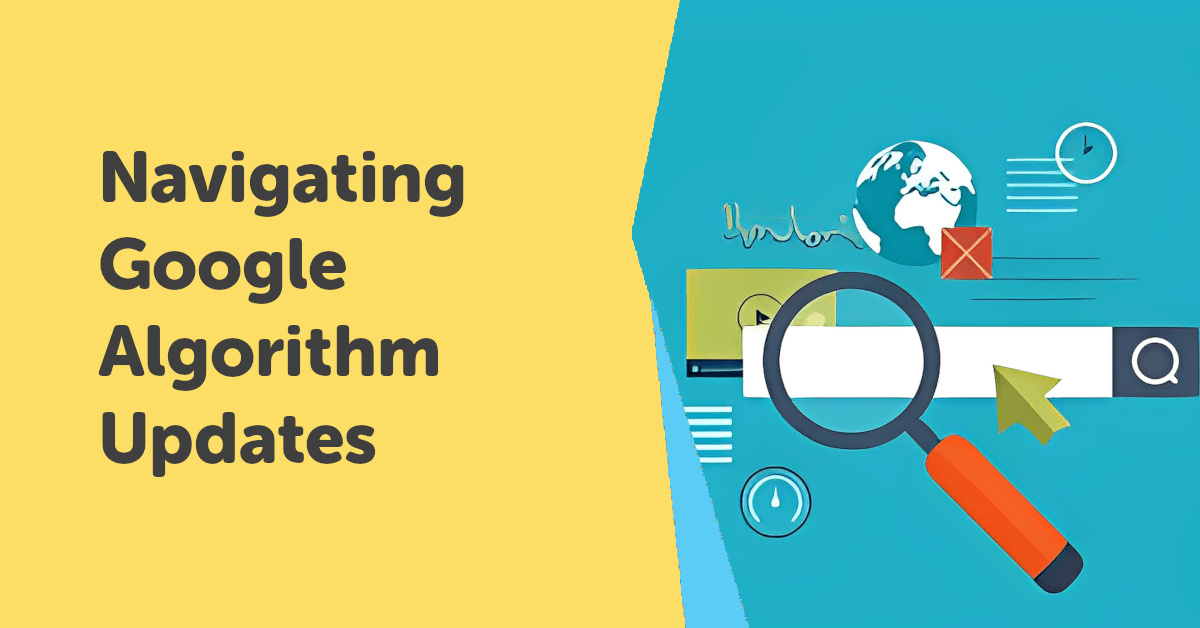
Ah, the digital world. It’s a rollercoaster. Let me share a little story with you, dear reader. A few years back, a mate of mine, Dave, and I were sat in a pub chatting away about Google’s reign over the digital landscape. Dave, bless him, was feeling a tad overwhelmed with all the Google Algorithm Updates and trying to keep up. I remember him saying, “It feels like every time I get a grip, Google pulls the rug out from under me.” I felt for him.
Oh, Google! That tech giant – our boon and bane. It’s given us this vast digital landscape, but navigating it? That’s a whole different kettle of fish. Google’s search engine has become so pivotal that even a minor change in its algorithm can send ripples across the online world. And those ripples? They can feel like tidal waves for us SEO folks. You know what I mean? 😅
Brief Overview of the Importance of Google’s Search Engine in Today’s Digital Landscape
Could you imagine a world without Google…nah, I can’t either. Google is like the heartbeat of the internet. It’s how most people find anything online. No wonder businesses are clamouring for a spot on its first page. Remember the good old Yellow Pages? Google’s like that, but on steroids. It’s THE place to be if you want to be seen. Can you remember the last time that you went to the trouble of checking the second page of search results? Me neither.
For many businesses, especially the small ones that don’t have a hefty ad budget, organic search ranking is their bread and butter. It’s a lifejacket in the sea of digital content. And because of this, Google has a lot of power – maybe too much. But who am I to judge?
Dynamic Nature of Google’s Search Algorithm
Remember the time when keyword stuffing was the thing? Cripse, those were some wild days! However, Google’s algorithm is a bit like the British weather – constantly changing and a tad unpredictable. Just when you think you’ve got a handle on it, Google rolls out a new update. Makes one want to pull their hair out, doesn’t it?
You might wonder, why does Google do this. Are they just trying to keep us on our toes? Maybe. But more importantly, they’re doing it to offer better search results to users. Fair enough. But the frequency and unpredictability of these changes? Cor blimey! They can make the life of an SEO expert a bit…tumultuous, to say the least.
Understanding Google’s Algorithm: A Primer
Before we delve deeper, let’s get our basics right. After all, you can’t navigate a storm without understanding the winds, can you?
History of Google’s Search Algorithm
Gosh, to think it all started in a dorm room! Back in the late ’90s, two Stanford students, Larry and Sergey (you might’ve heard of ’em), had this bright idea to create a new kind of search engine. They weren’t the first, but boy, did they shake things up!
Their big idea? Backlinks. Rather than just looking at a webpage’s content, they decided to consider the number and quality of links to a page. This PageRank system was revolutionary. Over time, as the internet grew and evolved, so did Google’s algorithm. And now? It’s like a big black box with loads of moving parts, and very hard to keep up with.
Core Purpose
Google’s core purpose: Delivering the Most Relevant Results to Users!
Now, as much as I grumble about Google’s shenanigans, I’ve gotta hand it to them – they’re always looking out for their users. At the heart of all these algorithm updates is a simple goal: to give users the best, most relevant search results.
You see, Google understands something very important. Its credibility, and thus its dominance, is based on its ability to deliver top-notch search results. If people can’t find what they’re looking for, they will just start using another search engine. And Google doesn’t want that. It’s a dog-eat-dog world out there.
Quality Content, Backlinks, and User Experience
Content is king – I’m sure you’ve heard that phrase thrown around more times than you can count. But it’s true. The quality of content is paramount. But what’s equally important is the user experience. There’s no point in having great content and visuals if your site’s slower than wet week.
And backlinks? They’re like votes of confidence. If reputable sites are linking to you, Google thinks, “Hmm, this site’s got some good stuff.” Beware of the fact that not all backlinks are equal. And if you’re thinking of getting dodgy backlinks, just don’t. Google’s got an eagle eye and it’ll catch you. Believe me, I’ve seen it happen. Not pretty.
Importance of Staying Updated
You know, the world of SEO isn’t for the faint-hearted. It’s a dynamic landscape and if you aren’t keeping up, you’re getting left behind. Remember Dave? You don’t want to end up like him, trust me.
Impact of Updates on Website Ranking
It’s no secret that Google’s updates can drastically impact website rankings. One day you’re sitting pretty at the top, and the next? You’ve dropped faster than a hot potato. And it’s not just about losing visibility – it’s about the potential business and revenue loss. I remember when a client of mine, a lovely lady named Karen, saw her website traffic plunge after an update. It was gut-wrenching. Took us months to recover.
Major Algorithm Updates: Winners and Losers
I’ve got some tales to tell here. Like the time when the Panda update hit in 2011. It targeted low-quality content, and oh boy, some big names took a hit. On the other hand, high-quality sites saw a massive boost. And who can forget the Penguin update? Sites with dodgy backlinks got a good whacking, I can tell you that. There are winners and losers every time, but it’s about learning and bouncing back.
Alright, here’s the brutal truth – if you don’t adapt, you risk everything. It’s not just about lost traffic or reduced visibility. It affects the bottom line. And in this digital age, if you’re not seen, you might as well not exist. Harsh? Maybe. But that’s the game, my friend.
Types of Google Algorithm Updates
Okay, let’s get into the nitty-gritty. Google’s updates aren’t just whimsical changes. They’re structured and serve specific purposes. Google’s updates can be bucketed into three main categories: Broad Core Updates, Focused Updates, and Real-time Updates. Stick with me here, and I’ll break it down for ya.
- Broad Core Updates are like major overhauls. They’re the big kahunas that can drastically shake up the SERPs. They don’t target specific niches or websites but rather focus on improving the overall search quality. Picture it as Google doing a bit of spring cleaning, tidying up its house, and making sure everything’s in top-notch order.
- Then we have the Focused Updates. These are your Penguins, Pandas, and oh, who can forget Mobilegeddon! These updates target specific issues. For instance, Penguin was all about penalising spammy link practices. Panda? It went after low-quality content. And Mobilegeddon? Well, as the name suggests, it prioritised mobile-friendliness. So, if your site wasn’t mobile-friendly, you could have felt a real pinch!
- Lastly, we’ve got Real-time Updates. Google’s algorithm is continuously learning and adjusting, on the fly. It’s like having a personal tutor who’s always checking your work, giving you feedback, and helping you improve. In a nutshell, the algorithm keeps evolving based on user interactions and feedback.
Staying Informed
By now, you’re probably thinking, “Alright Clint, but how do I stay in the loop with all these updates?” Well, glad you asked! Firstly, Google’s official channels are your best mates here. Google Webmasters Blog and the Google SearchLiaison Twitter are like the horse’s mouth – they’ll give you the most accurate info straight from the source.
But let’s not put all our eggs in one basket, shall we? SEO communities like Moz, Search Engine Land, and SEMrush Blog are fantastic resources. These folks eat, sleep, and breathe SEO, and they’re always on top of the latest changes. And then, of course, there are industry influencers. People like Rand Fishkin, Barry Schwartz, and the ever-insightful Danny Sullivan. They’ve been in the game for ages and their insights? Pure gold! 🌟
Navigating the Aftermath of an Update
Recognising the Symptoms of an Algorithm Change
First off, not every drop in your traffic means you’ve been hit by an algorithm update. It’s like when you have a cold – you might sneeze a lot, but it doesn’t mean you’ve got the flu. So make sure that you do a bit of detective work, before panicking. Start by checking Google Search Console for any spikes or drops in traffic, and investigate any error messages or notifications.
Auditing Your Website
Once you suspect that an algorithm update might have affected you, it’s time to roll up your sleeves and conduct a thorough website audit. Look for areas like content quality, backlink profile, mobile usability, and page speed. Remember, Google’s ultimate goal is to provide users with the best experience. If you keep that in mind, you’ll always be on the right track.
Recovery and Adaptation
Alright, so you’ve identified the problem areas. What next? Time to adapt. If it’s a content issue, try to rationalise and improve your articles. If backlinks are the culprit, work on cleaning up that profile. It’s a game of patience and persistence. And always remember: SEO isn’t a one-time gig; it’s an ongoing journey.
Best Practices and Strategies for Future-proofing
Embrace E.E.A.T (Experience, Expertise, Authoritativeness, and Trustworthiness)
E.E.A.T is the pie you want a piece of. Google loves content that showcases expertise, is authoritative in its niche, and can be trusted by users. So, ensure that you produce content that ticks these boxes. Do you have credentials or industry experience? Flaunt it!
Engage in Ethical SEO
Tempting as it may be, steer clear of those black-hat techniques. They might give you a short-lived boost, but in the long run, they’re more trouble than they’re worth. Stick to ethical, white-hat SEO practices. Remember, slow and steady wins the race.
Stay Updated
It’s not enough just to do things right; you’ve got to stay informed. Algorithm updates will keep coming. It’s like the tides – inevitable and constant. So, subscribe to industry news, join SEO communities, and always be on the lookout for any changes.
Parting Thoughts
Look, navigating Google’s algorithm updates can feel a bit like being on a rollercoaster. There are ups, downs, and the occasional loop-the-loop. But that’s what makes the SEO journey so thrilling!
Embrace the challenges, learn from the setbacks, and always be ready to adapt. And if you ever feel overwhelmed, remember – you’re not alone in this. We’re all on this wild ride together. So, buckle up, keep your wits about you, and let’s conquer the SEO world, one algorithm update at a time!
Diversifying Your Digital Presence
Why You Shouldn’t Keep All Your Eggs in One Basket
We’ve all heard this age-old saying, right? The digital landscape is vast and varied. While Google remains a significant player, it ain’t the only game in town. Relying solely on Google for your online presence is like eating only crisps for every meal. Tasty? Yes. Sustainable? Not so much.
Rising Stars: Bing, DuckDuckGo and Others
Let’s chat about the other search engines making waves. Bing, for example, may play second fiddle to Google, but it still has a decent market share, especially in certain regions. Then there’s DuckDuckGo, the privacy-focused engine that’s been garnering quite a bit of attention. For a world increasingly concerned about data privacy, this underdog might just surprise us all in the coming years.
Venturing into Voice Search and Local SEO
Ever tried shouting at your Alexa or Google Home for fun? I have, and let me tell you, voice search is another search channel to market! With more and more folks opting for hands-free search, it’s high time we start optimising our content for voice. And let’s not forget local SEO. Remember, the café around the corner might just be your biggest competitor.
The Road to Recovery
Penalties vs. Algorithmic Changes: Spot the Difference!
It’s a hard pill to swallow, but sometimes, we do get it wrong. Whether it’s a manual penalty or a dip due to an algorithmic change, it’s crucial to recognise what hit you. It’s like confusing a football with a rugby ball – they might look similar, but play entirely differently.
Recovering Like a Pro
Been slapped with a penalty? Ouch! But fear not, it isn’t the end of the road. Start by identifying the root cause – poor quality links, copied content, or sneaky redirects. Once you’ve pinpointed the problem, set out on a path of digital redemption. Disavow toxic backlinks, improve your content, and ensure your site provides genuine value to users.
Sending a Reconsideration Request
Once you’ve cleaned up your act, it’s time to ask Google for a second chance. Draft a sincere reconsideration request detailing the steps you’ve taken to rectify the issues. Remember, honesty is the best policy. Be open about your mistakes and showcase your efforts to fix ’em.
Reflections from the Digital Trenches
Overall, the world of SEO is ever-evolving. It’s unpredictable, challenging, but oh-so-rewarding. From the thrill of ranking #1 for a competitive keyword to the heartbreak of a Google penalty, I’ve seen it all. But through the highs and lows, one thing remains constant: the value of genuine, quality content. It’s the North Star that’ll guide you through the stormiest of SEO seas.
Finally, a massive shoutout to all you digital warriors out there. Keep pushing the boundaries, keep challenging the norms, and above all, keep learning. Remember, every setback is just a setup for a comeback. Keep calm and SEO on! 💪
Till next time, Keep rocking the digital boat! 🚀🌐


